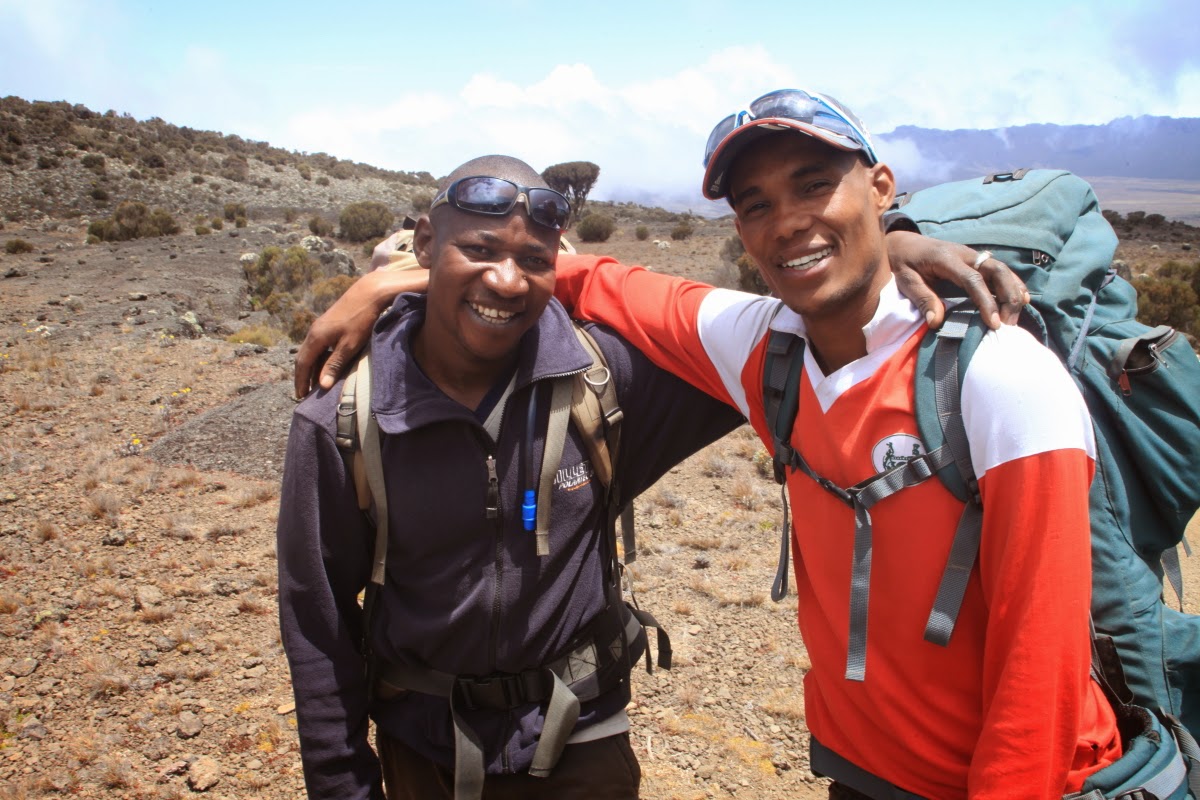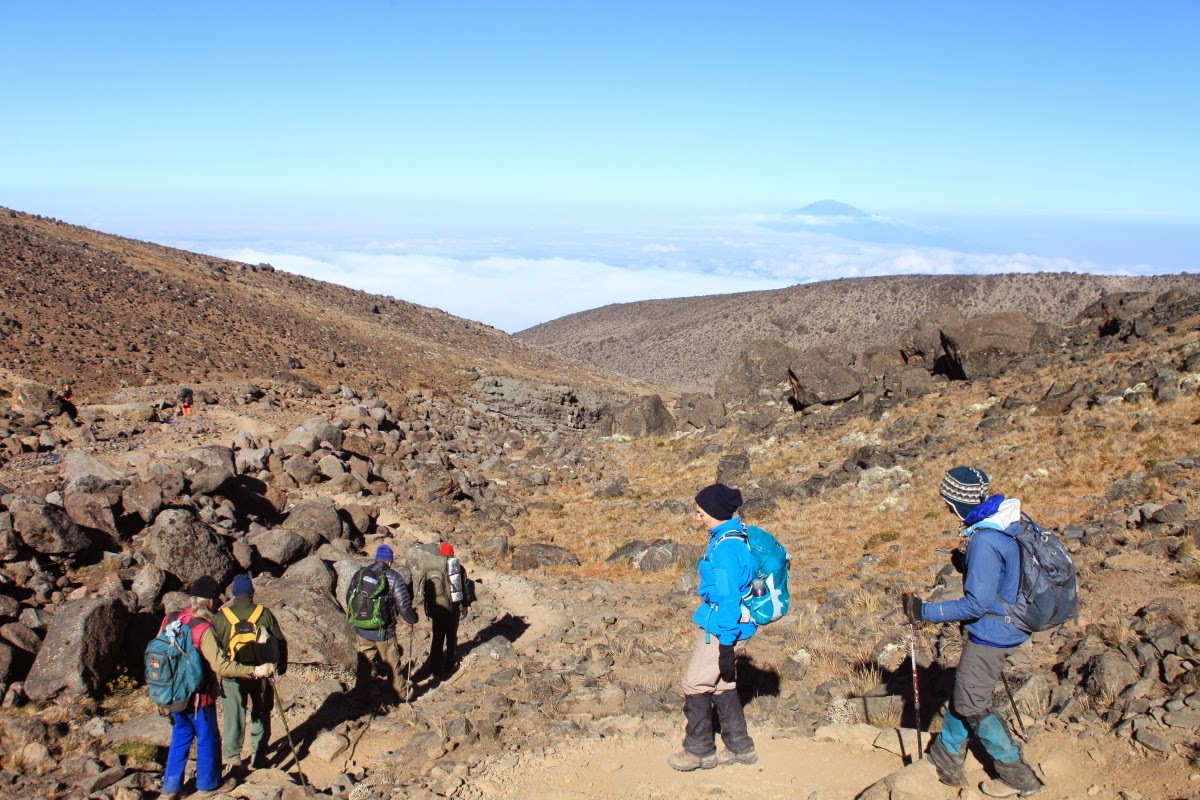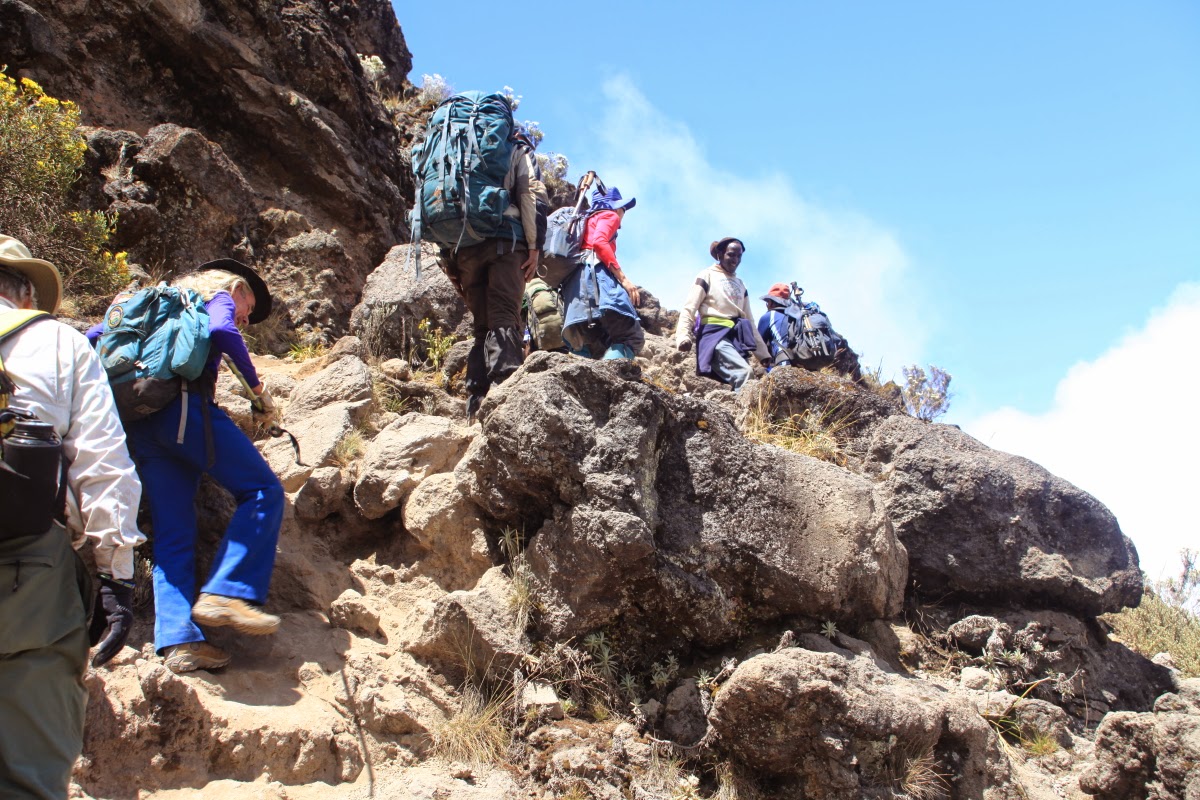Leaving Shira 1 Camp, the porters set out for their destination - Moir Hut Camp.
The landscape has definitely changed since the rainforest.
The Shira Plateau is really a valley surrounded by mountains. The valley now is a lava-filled caldera. But previously it was a huge volcano like Kili, before it lost its top. The Shira Volcano was the first volcanic cone built here, and the oldest lavas on it are about 1.6 million years ago. To think that this was the site of Kili-sized volcano, then catastrophically losing its top, only to be partially buried by lava flows from Kilimanjaro is incredible. The trekkers here are walking on the lava-flow surface.
This is a close-up of the main type of rock seen on Kilimanjaro - the rhomb porphory lava. These crystals grew inside a magma chamber beneath the volcano and were then erupted out with the lava like a modern-day slush drink.
Trekker crossing the Shira Emergency Route off of the mountain. This route is used to get people who suffer from AMS (Acute Mountain Sickness) off the mountain quickly.
Lobelia plants growing in the rocks. Stay tuned to the blog for other photos of the strange looking plants that grow on the slopes of Kilimanjaro.
Head guide James (left) and Assistant Guide Mathew.
We had two female porters in our group - Beatrice (left) and Tarasia.
Don W. and James examining a pyroclastic flow deposit on the slopes of Kilimanjaro. There were many outcrops of these flows, which originate in huge eruptive columns that collapse downward and outwards from the central vent. It is an chaotic arrangement of lava bombs and clasts often cover by finer ash-flow deposits.
Arriving at Moir Hut Camp August 15.
Helen celebrating her birthday on the mountain with Moir Hut Camp in the background.
Assistant guide Clemons checking his phone messages. There is cell service in many of the camps on Mt. Kilimanjaro.
Joe A. giving a wave on our acclimatization hike.
James checking his phone messages on the mountain. He was in constant contact with the office updated them about our progress.
The clouds parted and we got our first good view of the mountain!
Mt. Kilimanjaro from Moir Hut Camp.
Day 4 - Moir Hut Camp to Lava Tower Camp - August 16
Looking back to the west to the Shira Plateau (valley) and Shira Peaks. The Peaks outline the edge of the Shira caldera.
We were constantly keeping reference to our elevation and marked the moment we surpassed the elevation of Mt. Whitney in California at 14, 495 ft.
Some of the trekking involved climbing up rock faces.
Looking back to the Shira Cathedral to the south. These peaks are eroded remnants of the Shira caldera.
Note the trace of the trail heading east (bottom of photograph) toward the Lava Tower in the background.
Eroded hoodoos on the way to Lava Tower. These were originally laid down in a hot, glowing ash and rock cloud called a pyroclastic flow. When a volcano erupts and send rock and ash skyward, the material ultimately begins to fall back toward the earth. The increasingly concentrated mass of rock and ash compresses a layer of gas next to the ground surface and the rocks flow downhill on this cushion of gas. Pyroclastic flows therefore can move downslope extremely rapidly because they are frictionless on the gas - upwards to 100 miles per hour or more! Imagine a wall of glowing hot rock charging down a slope at these speeds. These rocks are the eroded remnants of such an event on Kilimanjaro.
More fantastic rocks on the trek to Kilimanjaro. Here welded fine-grain, ash flows cap an ignimbrite deposit. Ignimbrite is the term for rocks deposited in pyroclastic flows. These flows are extremely violent when erupted. To walk in the presence of these now cooled rock and ash clouds was an amazing experience.
Approaching the Lava Tower.
Lava Tower from camp. We went to the top of the tower.
All of us were pretty sure that we went to the top of the Tower only so the guides could see how well we climbed on rock walls - in preparation for the Great Barranco Wall the following day.
View of Lava Tower Camp from the top of the Lava Tower. Note our group of tents on the far right (six) with the yellow and red dinner tent right of them.
View down into the Arusha plain.
One of our first views on Mt. Meru to the west near the town of Arusha.
Looking up 4,000 feet to the top of Kilimanjaro near the Western Breach. Note the thick set of lava flows on the crest.
The dining tent where we took our meals. Only twice did we have to pack a lunch for the trail. Our hiking for the day was usually done by noon so that we could enjoy a hot lunch in the tent. The trail lunches included hard-boiled eggs, fried chicken, local peanuts, Cheese sandwiches on delicious white bread (!), and chocolate bars. The food was truly outstanding!
Day 5 - Lava Tower Camp to Barranco Wall and Karanga Valley- August 17
Sunrise on the Lava Tower.
Moonset over the Lava Tower.
Down through the rocks from Lava Tower Camp.
There was very little vegetation at this elevation but that would soon change.
Helen R. points the way, while Lauren looks on.
Much has been said in recent years about the shrinking of the glaciers on Kilimanjaro. These glaciers began their retreat in the mid-1800's with the end of the Little Ice Age. Since that time Kili's ice has shrunk by about 90%. In this photo the Kersten Glacier is seen draping over the south slopes of Kili.
Here is the Kilimanjaro senicio tree or giant groundsel (Dendrosenecio kilimanjari). You will have to "endure" a few of these pictures as we romped through the Garden of Senicios.
They appeared much like the Southwest Joshua Tree but had leafy tops.
With Kili in the background.
The trail went right through this garden of plants. The guides were keen on making time but a few of us wanted to photograph this other-world scene and lingered a little longer through this stretch.
With the Barranco Wall in the background.
Awesome scene with Senicio's on Kilimnajaro.
Note the hiker in the background (lower left).
The clouds began to move in as we approached the Barranco Valley.
Looking up to Kilimanjaro.
Climbing the lower sections of the great Barranco Wall.
It's not really a trail at this point but the climb is only about 15 minutes long.
Near the top of the Wall, Don W. contemplates our good fortune to experience this foreign world.
Helen R. making her way down into the Karanga Valley. The mountain was completely obscured in clouds at this point as we made our way to Karanga Camp. This moment was bit deflating to me, The descent meant that we had to climb another wall to the camp. The clouds were gray and gloomy. The fine dust had penetrated every part of us. I wondered, "Why?'






















































No comments:
Post a Comment
If your comment will not post, email me with the problem.